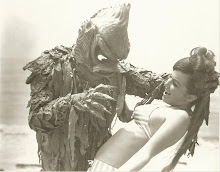But first, just what the heck is a regional horror film? One of the goals of this blog is to, hopefully, better define the boundaries of the backyard film, but for my purposes I'd say a regional horror film is one that was 1) produced independently; 2) was filmed outside of the immediate vicinity of Los Angeles; and 3) was made with a cast and crew consisting primarily of residents of the state in which the film was shot.
That's a fairly broad definition that covers everything from Night of the Living Dead (1968), The Texas Chain Saw Massacre (1974), Blood Feast (1963), and The Last House on the Left (1972), to Manos: The Hands of Fate (1966), Don't Look in the Basement (1973), Scarecrows (1988), Invasion of the Blood Farmers (1972) and Woodchipper Massacre (1988).
But just what does "independent" mean in this context? For the most part, anything shot without the support of an established studio or distributor, but I'd also include films that were made by companies that were smaller than AIP, provided they were headquartered outside of California.
So John Russo's Midnight (1982), which was made in Pennsylvania by an established production/distribution company (Independent-International Pictures) would qualify, but Sugar Hill (1974), which was made in Texas by American International Pictures with a cast and crew that hailed mainly from Hollywood, would not. Friday the 13th (1980), which was made independently in New Jersey before being picked up by Paramount, is a regional film; Squirm (1976), which was made by New York filmmakers in Georgia with backing from AIP, is not. Or is it?
There are a few films that I think of as regional productions that actually fall into a kind of gray area. AIP handed some money and a few actors to William Girdler for the unforgettable Exorcist knock-off Abby (1974), but that film looks a lot more like his homegrown Louisville productions than his later, studio-backed films. AIP similarly used Larry Buchanan's crew when it outsourced production of its cheap, made-for-TV horror films (The Eye Creatures, Zontar, etc.) to the Texas filmmaker.
Other films have even more convoluted pedigrees. The same New Jersey production team that brought us the Ginger series went all the way to New Mexico to make Track of the Moonbeast (1976), and New Yorker Robert Allen Schnitzer made The Premonition (1976) in Mississippi.
And there dozens of other strange geographical permutations of this phenomena of the regional horror film, too many to cover in this one post. I hope that, over time and with the help of whoever might wander over to read my musings, I can get a better handle on exactly what is and isn't a regional horror film, while sharing as much information as I can dig up about these often obscure pieces of backwood celluloid.
And what a collection of films we have to dissect! There have been thousands of books written about the horror film over the years, and they've been organized almost every way imaginable: chronologically, by subgenre, by studio, by director, by subject matter, by country of origin, and even by the amount of gore spilled per film, but you will find no other collection of films so odd and vast and varied as when you arrange U.S.-made fright flicks geographically. Some of the most influential horror films of the last four decades were regional productions, along with some of the most excruciatingly awful ones. A number of these films are beautifully shot masterworks; others are so cheap and handmade that they almost qualify as folk art. Suffice it to say that no matter where they were filmed or who made them, they are uniformly fascinating, peculiar, charming and almost never boring.
Okay, some of them are pretty boring. I promise not to dwell too long on those ones.
Finally, why "The Dead Next Door"? I actually stole the title from an Akron-lensed zombie flick made by J.R. Bookwalter, my former editor and a prolific producer/director who was previously and now is once again based in Ohio. I always liked the title, and thought it summed up the spirit of these films quite nicely. For the record, I asked J.R. before I copped the title. Also for the record, he stole the title from a Billy Idol song.
Until next time, here are a few snippets from some of my favorite regional monstrosities:




No comments:
Post a Comment